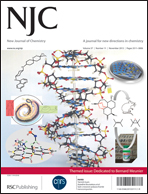Molecular tectonics: chiral 1- and 2-D zinc coordination networks based on chiral porphyrins bearing pyridyl and ethynylpyridyl appended units†‡
Abstract
Two chiral porphyrin based ligands bearing, at their opposite meso positions, two appended pyridyl or ethynylpyridyl units and chiral groups have been designed. For each ligand, both enantiomers were synthesised. In the presence of the Zn(II) cation, the chiral ligands become self-complementary chiral metallatectons upon binding of the metal centre by the tetraaza core of the porphyrin. Owing to the presence of both free coordinating pyridyl units and Zn atoms offering one or two coordination sites within the same entity, depending on the coordination number adopted by the metal centre, chiral 1D stair type networks and 2D grid type architectures are formed. Surprisingly, for the 2D network, although the removal of CHCl3 solvent molecules leads to the loss of structural integrity, the solvent-free crystals are nevertheless formed by changing the crystallisation conditions and the solvent mixture.

- This article is part of the themed collection: In honour of Bernard Meunier

 Please wait while we load your content...
Please wait while we load your content...